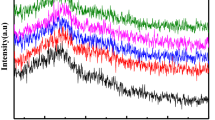Abstract
Titanium, vanadium and copper are normally present in glasses in their variable valency states but only Ti4+ (3d0), V5+ (3d0) and Cu+ (3d10) ions were found to exhibit charge transfer bands in glasses in the ultra-violet region of light. The molar extinction coefficients of these ions were calculated at their wavelength maxima in a 30Na2O·70SiO2 glass using Beer's-Bouger's equation and the intensities of their bands were found to lie of the order of around 103 gm mol lit−1cm−1. The values of the molar extinction coefficients for these ions were compared with those of Ce4+ (5d0), Cr6+ (3d0) and Fe3+ (3d5) ions calculated earlier in 30Na2O·70SiO2 glass at their wavelength maxima in UV-region. The mechanism of electronic transition was suggested as L → M, M → L and M → L → M charge transfer available till date as a result of absorption of high energy UV-radiation extensively for d0, d5 and d10 ions respectively in glass depending upon the glass melting conditions. The low energy tail, of the UV-bands due to all these ions were found to obey Urbach's Rule in the present sodium silicate glass. The intensities of the charge transfer bands due to these ions are expected to depend upon their nature and symmetries, electronic configurations and wavelength of maximum absorption in the glass.
Similar content being viewed by others
References
P. Nath, A. Paul and R. W. Douglas, Phys. Chem. Glasses 6(6) (1965) 203.
F. A. Cotton and G. Wilkingson, “Advanced Inorganic Chemistry,” Wiley-Interscience, New York, 1962, p. 549.
M. A. Sainz, A. Duran and J. M. Fernandez Navarro, Glass Technology 32(3) (1991) 99.
D. L. Wood and J. P. Remeika, J. Appl. Phys. 37 (1966) 1232.
A. Paul, “Chemistry of Glasses,” 3rd ed. (Chapman and Hall, London, 1990) p. 321.
F. N. Steele and R. W. Douglas, Phys. Chem. Glasses 6(6) (1965) 246.
S. P. Singh, Ram Pyare and P. Nath, in Collected Papers, XIV Intll. Cong on Glass, Vol. 1, 1986, p. 215.
M. Cable and Z. D. Ziang, Phys. Chem. Glasses 30(6) (1989) 237.
B. S. Bae and M. C. Weinberg, J. Amer. Ceram. Soc. 74(12) (1991) 3039.
V. J. H. Lee and R. Bruckner, Glastech. Ber. 55(11) (1982) 219.
S. P. Singh and A. Kumar, J. Mater. Sci. 30 (1995) 2999.
S. P. Singh, G. Prasad and P. Nath, J. Amer Ceram. Soc. 61(9/10) (1978) 377.
S. P. Singh, G. Prasad and P. Nath, Cent. Glass Ceram. Res. Instt. Bull. 25(2) (1978) 38.
S. Banerjee and A. Paul, J. Amer Ceram. Soc. 57(7) (1974) 286.
A. Duram and J. M. Fernandez Navarro, Phys. Chem. Glasses 26(4) (1985) 126.
M. Cable and Z. D. Ziang, Glastech. Ber. 62(11) (1989) 382.
V. P. Seth and A. Yadav, Phys. Chem. Glasses 28(3) (1987) 109.
K. Morinaga, H. Yoshida and H. Takebe, J. Amer. Ceram. Soc. 77(12) (1994) 3113.
S. Kumar, Cent. Glass Ceram. Res. Inst. Bull. 6(3) (1959) 99.
T. Bates, in “Modern Aspects of the Vitreous State,” Vol. 2, edited by J. D. Mackenzie (Butterworths, London, 1962) p. 195.
C. R. Bamford, “The Application of Ligand Field Theory to Coloured Glasses,” Phys. Chem. Glasses 3(6) (1962) 189, in Glass Science and Technology, Vol. 2 (Elsevier, New York, 1997) p. 166.
E. B. Sandell, “Colorimetric Determination of Traces of Metals,” 3rd ed. (Wiley-Interscience, New York, 1959) p. 926, p. 869, p. 443.
A. Kumar, Ph.D. thesis, Banaras Hindu University, Varanasi, 1991.
F. Irmann, J. Amer. Chem. Soc. 74(9) (1952) 4767.
P. Nath and R. W. Douglas, Phys. Chem. Glasses 6(6) (1965) 197.
A. Paul and R. W. Douglas, ibid. 6(6) (1965) 212.
T. Baak and E. J. Hornyak, Jr., J. Amer. Ceram. Soc. 44(11) (1961) 541.
W. D. Johnston, ibid. 47(4) (1964) 198.
A. Paul and R. W. Douglas, Phys. Chem. Glasses 6(6) (1965) 207.
P. Nath, A. Paul and R. W. Douglas, ibid. 6(6) (1965) 216.
P. Nath, Cent. Glass Ceram. Res. Inst. Bull. 13(2) (1966) 49.
R. Pyare, S. P. Singh, A. Singh and P. Nath, Phys. Chem. Glasses 33(3) (1982) 61.
S. P. Singh, G. Prasad and P. Nath, J. Mater. Sci. 16 (1981) 2176.
S. P. Singh and A. Kumar, Phys. Chem. Glasses 34(2) (1993) 45.
R. Pyare and P. Nath, J. Amer. Ceram. Soc. 65(11) (1982) 549.
R. Pyare and P. Nath, J. Non-Cryst. Solids 128(2) (1992) 154.
A. Kumar and S. P. Singh, Glastech. Ber. 65(3) (1992) 69.
W. D. Johnston and A. Chelko, J. Amer. Ceram. Soc. 49 (1966) 562.
R. S. Singh and S. P. Singh, Trans. Ind. Ceram. Soc. 59(3) (2000) 47.
R. S. Singh and S. P. Singh, Phys. Chem. Glasses 40(4) (1999) 235.
Author information
Authors and Affiliations
Rights and permissions
About this article
Cite this article
Singh, R.S., Singh, S.P. Spectrochemical studies on charge transfer bands due to d0, d5 and d10 ions in a sodium silicate glass. Journal of Materials Science 36, 1555–1562 (2001). https://doi.org/10.1023/A:1017569302319
Issue Date:
DOI: https://doi.org/10.1023/A:1017569302319



